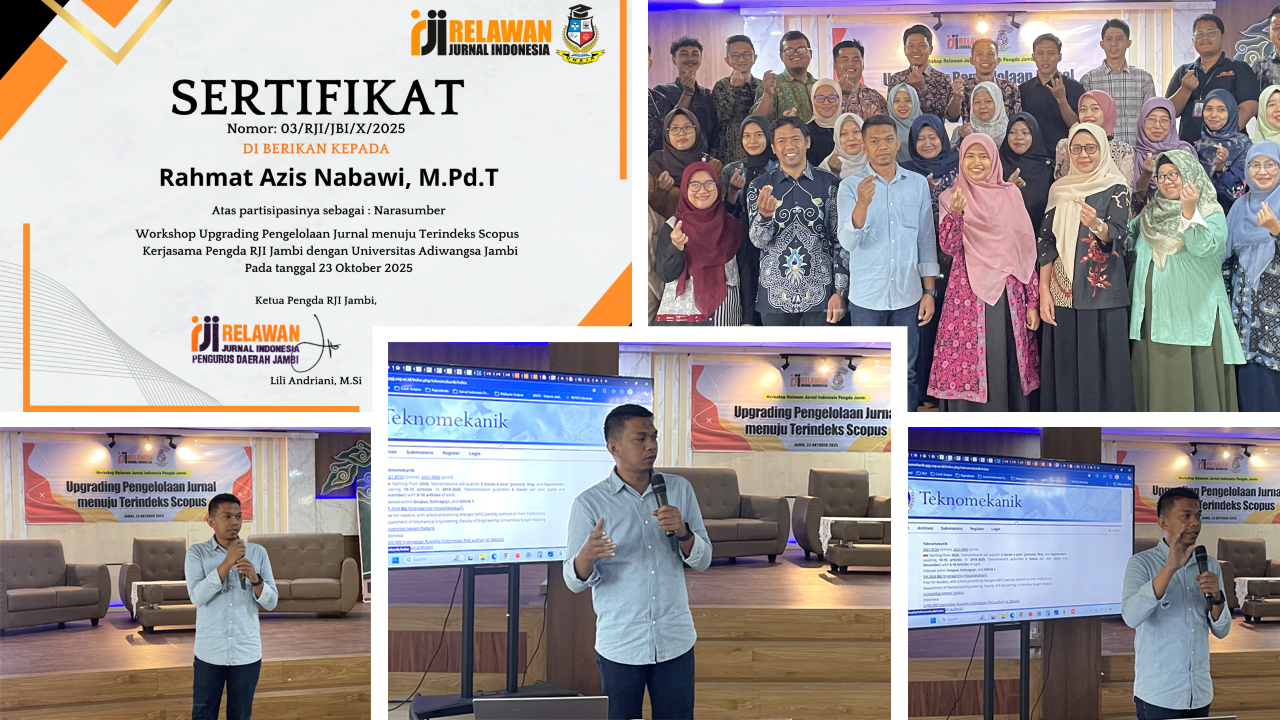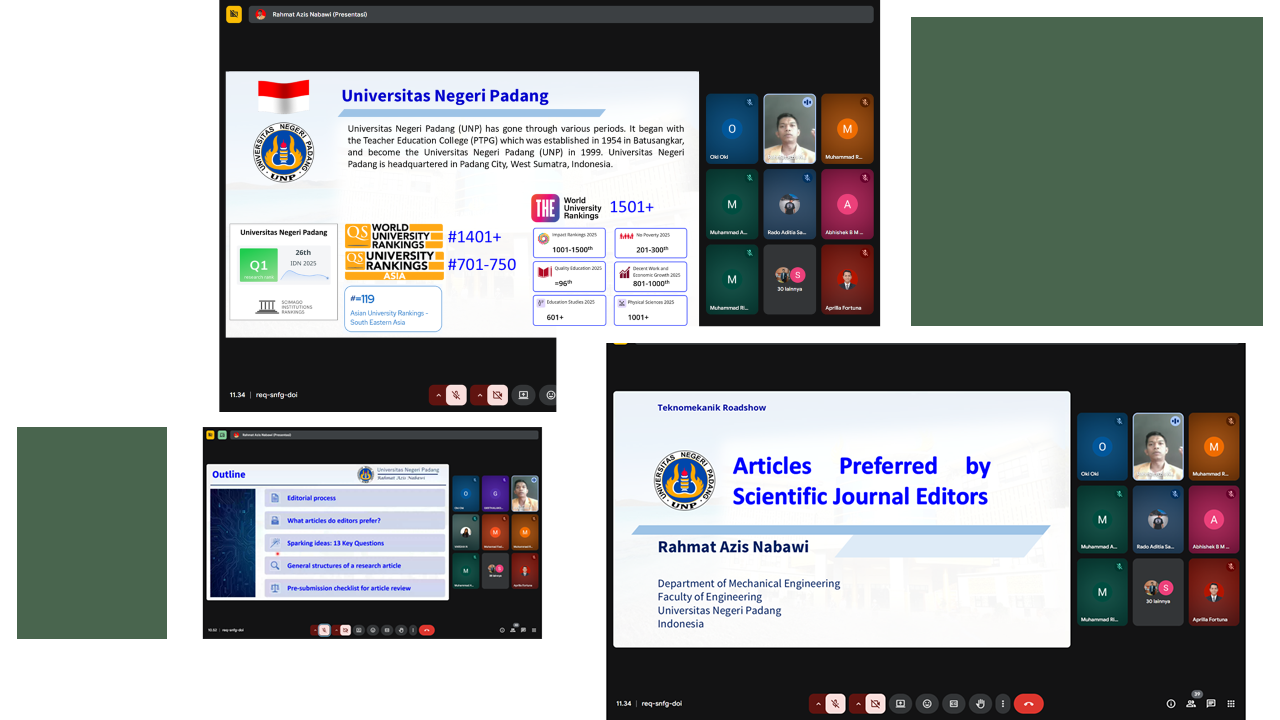Numerical analysis of flow characteristics of the oil-water mixture in stratified-annular horizontal pipe
DOI:
https://doi.org/10.24036/teknomekanik.v5i2.14572Keywords:
Numerical anlysis, Fluid-mixture velocity, Pressure drop, Horizontal pipeAbstract
The loss of oil fluid flow in the piping system in the petroleum industry due to friction is the cause of low efficiency. To reduce friction loss, the viscosity of petroleum can be lowered by adding water as a mixture. Actually, the flow loss in a piping system is influenced by several factors including flow pattern, fluid type, flow velocity, flow pressure and pipe diameter. This study aims to determine the effect of flow patterns on changes in velocity in the two-phase flow of oil and water in a piping system. This numerical analysis research was carried out using Fluent 6.2 software with variations in the velocity of the oil-water mixture: 0.2, 0.4 and 0.6 m/s. The simulation results show that the greatest pressure loss occurs at a fluid velocity of 0.6 m/s where the flow is stratified mixed. While the smallest pressure loss at a mixture velocity of 0.2 m/s when the flow is stratified smooth. From the results of the study, it can be concluded that the increase in fluid flow velocity has a positive correlation with the increase in the value of flow losses in the pipe.
Downloads
References
A. Bonilla-Riaño, H. F. Velasco-Peña, A. C. Bannwart, H.-M. Prasser, and O. M. H. Rodriguez, “Water film thickness measurement system for oil-water pipe flow,” Flow Measurement and Instrumentation, vol. 66, pp. 86–98, Apr. 2019. https://doi.org/10.1016/j.flowmeasinst.2019.02.007
F. W. Didik Fajar Afrizayatman, “Inspection Measuring Point Optimization on Piping System at PT. Pertamina Hulu Mahakam (PHM),” 2019.
K. Matsumoto, Y. Shiokawa, M. Okada, T. Kawagoe, and C. Kang, “Ice storage system using water–oil mixture Discussion about influence of additive on ice formation process,” International Journal of Refrigeration, vol. 25, no. 1, pp. 11–18, Jan. 2002. https://doi.org/10.1016/S0140-7007(01)00024-X
G. Boyun, S. Song, A. Ghalambor, and T. R. Lin, Offshore Pipelines. Elsevier, 2014. https://doi.org/10.1016/C2012-0-01131-3
A. S. Tyusenkov and O. A. Nasibullina, “Corrosion of tubing of oil fields,” IOP Conf Ser Mater Sci Eng, vol. 687, no. 6, p. 066016, Dec. 2019. https://doi.org/10.1088/1757-899X/687/6/066016
P. N. Dubey, R. K. Verma, G. Verma, and G. R. Reddy, “Design and Analysis of Piping and Support,” in Textbook of Seismic Design, Singapore: Springer Singapore, 2019, pp. 379–418. doi: 10.1007/978-981-13-3176-3_11.
M. S. Shadloo, A. Rahmat, A. Karimipour, and S. Wongwises, “Estimation of Pressure Drop of Two-Phase Flow in Horizontal Long Pipes Using Artificial Neural Networks,” J Energy Resour Technol, vol. 142, no. 11, Nov. 2020, https://doi.org/10.1115/1.4047593
H. Ferroudji, A. Hadjadj, A. Haddad, and T. N. Ofei, “Numerical study of parameters affecting pressure drop of power-law fluid in horizontal annulus for laminar and turbulent flows,” J Pet Explor Prod Technol, vol. 9, no. 4, pp. 3091–3101, Dec. 2019, https://doi.org/10.1007/s13202-019-0706-x
S. Kumar Senapati and S. Kumar Dash, “Computation of pressure drop and heat transfer in gas-solid suspension with small sized particles in a horizontal pipe,” Particulate Science and Technology, vol. 38, no. 8, pp. 985–998, Nov. 2020. https://doi.org/10.1080/02726351.2019.1649335
A. Rawat and H. Kalman, “Particle velocity and stationary layer height analysis for modification and validation of particulate Plug-2 pressure drop model,” Powder Technol, vol. 361, pp. 867–879, Feb. 2020. https://doi.org/10.1016/j.powtec.2019.11.011
A. R. Al-Obaidi, “Investigation of fluid field analysis, characteristics of pressure drop and improvement of heat transfer in three-dimensional circular corrugated pipes,” J Energy Storage, vol. 26, p. 101012, Dec. 2019. https://doi.org/10.1016/j.est.2019.101012
K. P. Jang and M. S. Choi, “How affect the pipe length of pumping circuit on concrete pumping,” Constr Build Mater, vol. 208, pp. 758–766, May 2019. https://doi.org/10.1016/j.conbuildmat.2019.03.023
M. Kandil, A. M. Kamal, and T. A. El-Sayed, “Effect of pipematerials on water hammer,” International Journal of Pressure Vessels and Piping, vol. 179, p. 103996, Jan. 2020. https://doi.org/10.1016/j.ijpvp.2019.103996
Y. Baghernejad, E. Hajidavalloo, S. M. Hashem Zadeh, and M. Behbahani-Nejad, “Effect of pipe rotation on flow pattern and pressure drop of horizontal two-phase flow,” International Journal of Multiphase Flow, vol. 111, pp. 101–111, Feb. 2019. https://doi.org/10.1016/j.ijmultiphaseflow.2018.11.012
R. Abd Elkhalek, M. Awad, and L. Sakr, “Experimental Study of Flow Patterns and Pressure Drop Reduction in Pipes of Oil-Water Flow,” Bulletin of the Faculty of Engineering. Mansoura University, vol. 43, no. 1, pp. 18–30, Jun. 2020. https://doi.org/10.21608/bfemu.2020.94530
T. Ganat, M. Hrairi, and S. Regassa, “Experimental investigation of gas–oil–water phase flow in vertical pipes: influence of gas injection on the total pressure gradient,” J Pet Explor Prod Technol, vol. 9, no. 4, pp. 3071–3078, Dec. 2019. https://doi.org/10.1007/s13202-019-0703-0
F. L. Rashid, H. N. Azziz, and S. M. Talib, “Experimental Investigation of Drag Reduction by a Polymeric Additive in Crude Oil Flow in Horizontal Pipe,” Journal of Advanced Research in Fluid Mechanics and Thermal Sciences, vol. 60, no. 1, pp. 15–23, 2019, Accessed: Dec. 08, 2022. [Online]. Available: https://akademiabaru.com/submit/index.php/arfmts/article/view/2625
H. Huang, X. Zou, L. Li, X. Li, and Z. Liu, “Energy-Saving Design Method for Hydraulic Press Drive System with Multi Motor-Pumps,” International Journal of Precision Engineering and Manufacturing-Green Technology, vol. 6, no. 2, pp. 223–234, Apr. 2019. https://doi.org/10.1007/s40684-019-00085-6
G. Elseth, “An Experimental Study of Oil/Water Flow in Horizontal Pipes,” The Norwegian University of Science and Technology, Porsgrunn, 2001.
M. Al-Yaari, A. Soleimani, B. Abu-Sharkh, U. Al-Mubaiyedh, and A. Al-sarkhi, “Effect of drag reducing polymers on oil–water flow in a horizontal pipe,” International Journal of Multiphase Flow, vol. 35, no. 6, pp. 516–524, Jun. 2009. https://doi.org/10.1016/j.ijmultiphaseflow.2009.02.017
A. B. Desamala, A. Dasari, V. Vijayan, B. K. Goshika, A. K. Dasmahapatra, and T. K. Mandal, “CFD Simulation and Validation of Flow Pattern Transition Boundaries during Moderately Viscous Oil-Water Two-Phase Flow through Horizontal Pipeline,” World Academy of Science, Engineering and Technology, International Journal of Chemical, Molecular, Nuclear, Materials and Metallurgical Engineering, vol. 7, pp. 80–85, 2013.
Z. H. Gu, H. L. Wen, Y. Yao, and C. H. Yu, “A volume of fluid method algorithm for simulation of surface tension dominant two-phase flows,” Numerical Heat Transfer, Part B: Fundamentals, vol. 76, no. 1, pp. 1–17, Jul. 2019. https://doi.org/10.1080/10407790.2019.1642048
G. Goncalves, M. Magnini, O. Matar, G. Goncalves, M. Magnini, and O. Matar, “Numerical Simulation of Crude-Oil Fouling with the Volume-of-Fluid Method,” APS, p. S41.004, 2019, Accessed: Dec. 08, 2022. [Online]. Available: https://ui.adsabs.harvard.edu/abs/2019APS..DFDS41004G/abstract
J. L. Trallero, C. Sarica, and J. P. Brill, “A Study of Oil/Water Flow Patterns in Horizontal Pipes,” SPE Production & Facilities, vol. 12, no. 03, pp. 165–172, Aug. 1997. https://doi.org/10.2118/36609-PA

Additional Files
Published
Issue
Section
License
Copyright (c) 2022 Nelvi Erizon, Jasman Jasman, Irzal Irzal, Muhammad Fikhri Aldio, Aprizal Saputra, Chau Trung Tin (Author)

This work is licensed under a Creative Commons Attribution 4.0 International License.






